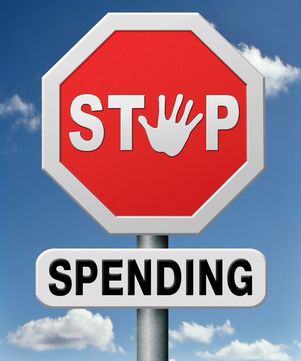|
MN writes
"I am in dire need of help with huge debt. My first issue is denial, unable to collect my mail out of letterbox knowing I will collect bills and I just don't want to see them. Is there any help in this situation? Thankyou. Do you have the answer? If you have a suggestion or idea for MN let us know, by leaving it in the comments below. We'll enter your answer into our Tip of the Week competition, with a one-year membership to the Cheapskates Club as the prize. And keep an eye open, you may even see your answer in next week's newsletter.
3 Comments
Dianne asks
"My husband and I have been married for five months, and are currently living with his parents. This is their wedding gift to us, so we can save as much as possible as a deposit on a home of our own. They offered us rent and utility free living for two years, which we are grateful for. The problem is grocery money (of all things!). Because of our work schedules, my MIL also does the grocery shopping and cooking (she's a great cook, I'm learning heaps) and we split the bill 50-50. Here's the rub: she does all the grocery shopping Coles and refuses to go anywhere else. She doesn't look for markdowns or specials, and flatly refuses to even consider generic brands. Last month our share of the grocery bill was $1,365 - even living rent free, we can't afford that! How can I , at 25 years old and a newlywed, tactfully introduce the idea of smart and frugal, budget shopping without any offence to my mother-in-law, who has been a housewife for 30+ years and has never needed to budget? Do you have the answer? If you can help Dianne let us know, by leaving it in the comments below. We'll enter your answer into our Tip of the Week competition, with a one-year membership to the Cheapskates Club as the prize. And keep an eye open, you may even see your answer in next week's newsletter. I think it’s time for a No Spend week. Can you live without spending for a week? We haven’t had a No Spend challenge for a while and this is just for one week, seven short days.
The rules are simple: no spending unless it is essential. You can pay your regular bills that fall due this week and buy your groceries (as long as you stick to the list), as long you have the cash to pay for them. Because this No Spend challenge is going to be a little different. Cash only. No credit cards, no debit cards, just old fashioned cash. Here are some tips that will make your spending freeze easier: Register Register in the comments field below and tell us how much you are hoping to not spend. Then keep us up to date with your progress. This is important, we all want to know how well you are doing and if you post regularly you'll be able to see how we are getting on too. Bookmark this page so you can find it again easily. Have a Plan Planning is the key to surviving and thriving during a spending freeze. Planning ensures you cover everything you need to get through: lunches, groceries, drinks, having enough petrol in the car etc. Planning and knowing what's happening will let you prepare ahead of time and find no spend alternatives to those "spend, spend, spend" situations. Get Your Cash After you've planned your no spend week go to the bank and get the cash you'll need. Remember, no plastic this week. You might find it easier to actually go into the bank and get your cash in a variety of denominations. Divvy up the cash according to your anticipated expenses (aren't you glad of those smaller denominations now?) and put each amount into a labelled envelope or ziplock bag. Then when you need to spend, you can take the money from the right bag. Stop Spending Seriously, stop spending money - no clothes, magazines, toys, makeup, computer bits and bobs, shoes etc. For seven days use your money to pay the essential living expenses (mortgage/rent, utilities, food - bare bones basics, fares/petrol) and see just how much is left over at the end of the week. You must bank the leftover money - it is not saved until it is safely in the bank it is just not spent. Track Your Spending If you track your spending already, fantastic. Pat yourself on the back. If you don't, start today. Get a notebook (any notebook or piece of paper will do) and write down every cent you spend for the next seven days. Write down what you bought and how much it cost. Do this so you can see exactly what you are spending your money on. Good luck. I can't wait to see how you do. Willow wreaths are so easy to make and they look lovely, either as they are or decorated. I use small willow wreaths to decorate our Christmas tree. If you want to use them for the same thing, you need to make them now so they have time to dry.
To make a small willow wreath, approximately 5cm in diameter you need one long or two short willow strands. Step 1. Strip the leaves from the strands. Step 2. Take one strand and twist it into a small circle. Weave one end around the circle to secure. Step 3. Take the other end and weave it in and out of the circle until you reach the end. Step 4. Tuck the end into the weaving to secure. Step 5. Lay the wreaths on several thicknesses of newspaper and place them in a warm, dry spot (in front of a sunny window is ideal). Turn the wreaths every day or so. Leave them for a month until they have dried. To decorate use craft paints to spray them gold, silver or red. Use a hot glue gun to stick berries, flowers, bows or other embellishments. Cut a 10cm length of narrow ribbon. Fold in half and glue raw edges to the back of the wreath. Let the glue dry then hang by the ribbon. Where to find willow: Weeping willows grow all over the place. They were once very common but have fallen out of favour due to their creeping and invasive roots. You'll still find them in parks and along creeks and waterways, or even along the side of a country road. I make Wayne stop at the picnic area between Goulbourn and Yass every time we are coming home from Sydney so I can collect a few more willow strands (the willows are on the southbound side of the freeway, which is why we stop on the way home). If the willow is on private property ask permission before taking just the number of strands you need to make your wreath. Rachel writes
"Hello, I recently read about eco-eggs which are basically laundry detergent replacements. Here's what they claim: 'The award winning Laundry Egg is a complete replacement for washing detergent. Just pop it in the drum of your washing machine – no powder, liquid, tablets or gels required. The two types of mineral pellets inside the egg get to work, producing powerful – but natural – cleaning foam which powers through the fibres lifting off the dirt and grime.' Has anyone used them? Do they work?" Do you have the answer? If you can help Rachel, let us know, by leaving it in the comments below. We'll enter your answer into our Tip of the Week competition, with a one-year membership to the Cheapskates Club as the prize. And keep an eye open, you may even see your answer in next week's newsletter. In this Newsletter
1. Cath's Corner 2. In the Tip Store - Keep Chickens for Easy Eggs; A Newsworthy 21st Birthday Present; Give Wallpaper a Softening Treatment 3. Share Your Tips 4. On the Menu - Simple Lemon Cake 5. The $300 a Month Food Challenge with Wendy - Stockpiling for Summer 6. Cheapskates Buzz - Cheapskaters are talking in the Forum and on Cath's blog 7. Member's Featured Blog - I'm Revolting 8. Last Week's Question - Is there a frugal Armor All Replacement 9. This Week's Question - Do Eco Eggs work? 10. Ask Cath 11. Join the Cheapskates Club 12. Frequently Asked Questions 13. Contact Details Click here to read the complete newsletter |
Archives
April 2020
Categories
All
|


 RSS Feed
RSS Feed